As we saw in my last post, by 1880, four of the five surviving children of Gerson and Eva (Goldschmidt) Katzenstein were on their own. SJ, their oldest child, was married to his second cousin Henrietta Sigmund and living in Washington, Pennsylvania, where he was a merchant. Brendina, the older daughter, was married to Jacob Schlesinger and living in Philadelphia, where Jacob worked as a butcher. Jacob and Perry Katzenstein, the second and third sons of Gerson and Eva, were living together in Pittsburgh and working as salesmen. Only my great-grandmother Hilda, who was seventeen in 1880, was still living at home with her parents in Philadelphia.
During the 1880s, Gerson and Eva were blessed with many grandchildren. SJ and Henrietta, whose first child Moynelle was born in 1879, had four sons in the 1880s: Milton (1881), Howard (1882), Ivan (1884), and Earl (1885). Brendina and Jacob already had four children by 1880, Heloise (1874), Solomon Joseph (1875), and Alfred (1879), and a fourth child, Sidney, was born in 1880. Their daughter Aimee was born seven years later in 1887.
In 1884 or 1885 (sources vary), Perry Katzenstein married Rose Elias, daughter of Samuel Elias and Fanny Greenwald. Rose was born in Jersey Shore, Pennsylvania, which is, strangely enough, nowhere near the New Jersey shore. In fact, it’s about 250 miles west of the Atlantic and about 190 miles west of Philadelphia and 180 miles east of Pittsburgh. Rose’s parents were both German immigrants, and her father was a merchant. In 1880, her father was selling liquor; in 1870, he’d been selling clothing. In 1887, Perry is listed in the Philadelphia directory at the same address as his father, Gerson—870 Marshall Street.
His brother Jacob is listed right down the street at 919 Marshall Street in that same directory for 1887. Sometime before September 16, 1886, Jacob Katzenstein had married Ella Bohm, daughter of Marcus Bohm. I cannot find any official records for Ella, except for this birth record indexed on FamilySearch:
Unfortunately, it did not reveal Ella’s original surname or anything else about her. But it does show that their son Milton was born in Philadelphia in 1886, suggesting that they were all living there at that time. I found her original surname and her father’s name from other sources, discussed below.
Jacob’s residence during the 1880s is a bit of a mystery. I cannot find him on the 1880 census. In 1881, he is listed in the Pittsburgh directory, living with Perry. In 1884, he is listed in the Johnstown, Pennsylvania, directory, and in 1887, he is listed in both the Johnstown and Philadelphia directories. I have no idea whether Ella was from Philadelphia, Johnstown, or someplace else. I don’t know where or when she and Jacob were married. I did find this quote about Jacob on my cousin Roger’s old website:
[Jacob] came to Johnstown in 1882, as a clerk for Louis Cohen. He returned to Philadelphia for a few years but then came back to take charge of the Economy clothing Store which belonged to Amos Sulka and himself. (quoting Leonard Winograd, The Horse Died at Windber: A History of Johnstown’s Jews of Pennsylvania (Wyndham Hall Press, 1988)).
Jacob and Ella had a second son named Edwin born apparently on June 5, 1887, a date I determined from his headstone, as discussed below. But June 5, 1887 is less than nine months after Milton’s birth date of September 16, 1886. It seems highly unlikely that a woman could have had two children less than nine months apart. I assume one of those birth dates is off by at least a few months, or that Edwin was premature, or that Ella conceived almost immediately after Milton was born. Or that Ella was not the biological mother of one of those two children.
In 1888, Gerson and Eva saw their youngest child get married. Hilda, my great-grandmother, married Isidore Schoenthal in Philadelphia. As I’ve written previously, Hilda and Isidore first lived in Pittsburgh, where on December 3, 1888, their first son was born, my great-uncle Lester Schoenthal.
Thus, by 1888, Gerson and Eva’s children were all married, and there were twelve grandchildren. Things must have seemed quite good for them all, but in 1889, their fortunes began to change. First, on April 18, 1889, Jacob and Ella’s son Milton died; he would have been only two and a half years old. I learned of his death from an entry on FindAGrave showing his headstone at Grandview cemetery in Johnstown:
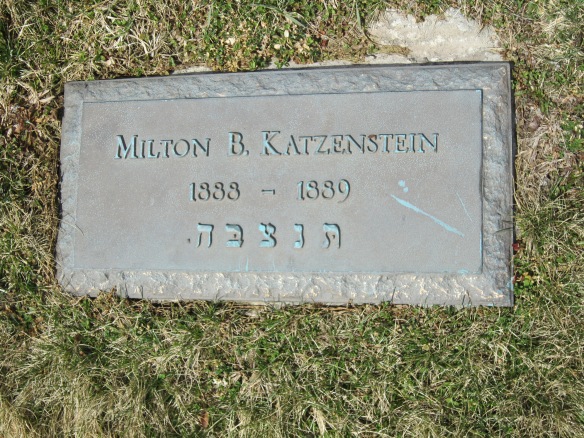
FindAGrave courtesy of Michelle
http://www.findagrave.com/cgi-bin/fg.cgi?page=gr&GSln=katzenstein&GSfn=milton&GSbyrel=all&GSdy=1889&GSdyrel=in&GSob=n&GRid=103655922&df=all&
But the headstone says he was born in 1888, not 1886 as the Philadelphia birth record stated. So I searched the interment database for Grandview cemetery in Johnstown and saw that the interment record indicates that Milton was two when he died in April, 1889, suggesting that the headstone is wrong and the birth record and interment record are right. Very odd. I also learned from the interment record that Milton’s middle name was Bohm, his mother’s birth name.
A little over a month after Milton’s death in Johnstown, one of the most tragic events in American history occurred: the Johnstown flood of May 31, 1889. Over two thousand people died that day. According to the Johnstown Area Heritage Association (JAHA) website, that was the largest loss of civilian life in America in one day until September 11, 2001.
The JAHA website and several other sources describe how after several days of heavy rain, the South Fork dam, which was in need of repairs, collapsed, causing havoc and death as the rushing waters swept everything in its path under and aside.

The aftermath of the Johnstown Flood (Johnstown, Pennsylvania). “The Debris above the Pennsylvania Railroad Bridge.” In: “History of the Johnstown Flood”, by Willis Fletcher Johnson, 1889. P. 199. Library Call Number M79.4 J71h. (Photo credit: Wikipedia)
Here is how the JAHA described it:
20 million tons of water rushed down the narrow Conemaugh Valley like a moving mountain of water at an average speed of 40 miles per hour. The “terrible wave” picked up houses, trees, and even trains on its way down the valley. It flattened a railroad bridge. It swept whole towns away as it made its way to the city of Johnstown.
By the time it reached Johnstown the flood didn’t even look like water anymore. People who saw it coming said it looked like a moving, boiling black mountain of junk. 35 feet high at its crest, it had the force of Niagara Falls. Even the best swimmers couldn’t swim in that mess. Many people drowned. For most, the only warning was a thunderous rumble before the water hit.
In minutes, most of downtown Johnstown was destroyed. Survivors clung to roofs, debris, and the few buildings that remained standing. Others who weren’t killed instantly, were swept down the valley to their deaths.
Just when it seemed like it couldn’t get worse, it did. All that wreckage piled up behind the Pennsylvania Railroad’s Stone Bridge. People who managed to survive so far became trapped in the huge pile of debris, all wrapped in a tangle of barbed wire from destroyed Gautier Wire Works. Then the pile, which was 40 feet high and 30 acres across, caught fire!…
Four square miles of downtown Johnstown was completely leveled, including about 1600 homes, 280 businesses, and much of the Cambria Iron Company. Even more tragic was the loss of life. 2,209 people are known to have died in the flood waters. 99 whole families perished. 400 children under the age of ten were killed.
Among those who lost their lives in the flood were Ella Bohm Katzenstein, Jacob’s wife, and their younger son, Edwin, who was just five days short of his second birthday.
Note that this list includes Ella (identified by her birth name incorrectly as Ellen) and her son among those who were killed and Jacob on the list of those who survived.
Jacob Katzenstein had lost his entire family starting with Milton on April 18 and then, 43 days later, he lost Ella and Edwin in the flood.
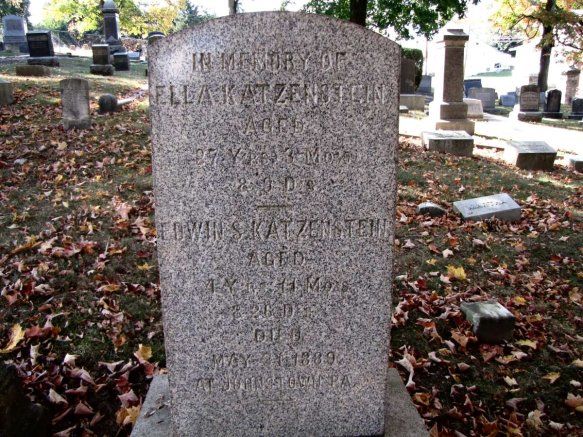
Headstone of Ella and Edwin Katzenstein, FindAGrave, courtesy of Byron http://www.findagrave.com/cgi-bin/fg.cgi?page=gr&GRid=118211407&ref=acom
The headstone allowed me to infer the birthdates for Ella (February 1862) and Edwin (June 5, 1887), as it says Ella was 27 years, six months, and zero days old at her death on May 31, 1889, and that Edwin was one year, eleven months, and six days old that day.
The odd thing is that this headstone is located at Eastview Cemetery in Cumberland, Maryland, not at Grandview Cemetery in Johnstown where Jacob and Ella had buried Milton the month before. Also, note that the stone says “In Memory of,” an indication to me that it is not marking a grave, but is just operating as a memorial. Maybe the bodies of Ella and little Edwin were never found. (I’ve contacted the Eastview Cemetery to see if they have more information, but so far they’ve not found any information about the stone, who put it there, or whether Ella and Edwin are in fact buried there.)
But why is this memorial in Cumberland? Jacob was living in Johnstown; his parents were living in Philadelphia. The only Katzenstein family members I know of who were living in Cumberland at that time were some members of the family of H.H. Mansbach, Jacob Katzenstein’s first cousin. Did the Mansbach family install this memorial? I am still trying to figure this one out.
It is hard to imagine the devastation caused by this flood. Over two thousand lives lost as well as all the injuries and the destruction of the town itself. Just as we cannot really grasp the full meaning of the more than two thousand people who died on 9/11, we cannot truly understand the impact of this tragedy unless we focus on one life at a time and the story of that life. Trying to imagine what this must have been like for Jacob Katzenstein gives me a better sense of how horrifying and devastating the flood must have been, multiplying his story over two thousand times.
It also makes me want to know more about Ella Bohm, the woman he married. I am still trying to learn more about her. All I know now is that she was born in February, 1862 (based on that headstone), that her father’s name was Marcus Bohm, that she had two sons, Milton and Edwin, and that both of them died as toddlers. She was only 27 on May 31, 1889, when she died along with her son Edwin and the 2,207 other people who were killed in the Johnstown flood.
I will write more about her in my next post.



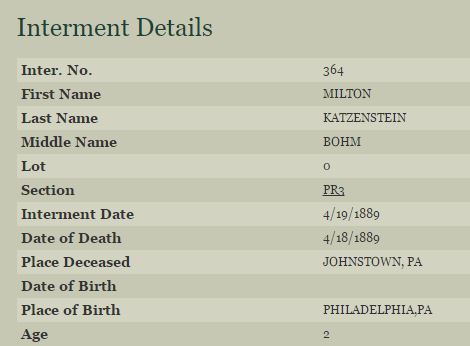
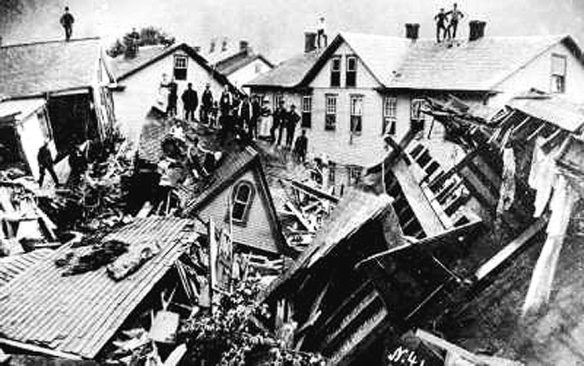
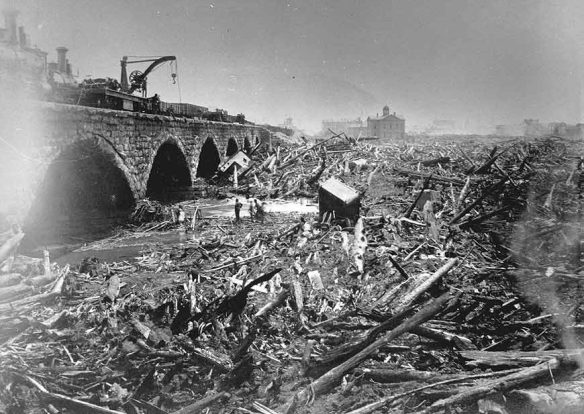


Wow! What a devastating event. I wish you the best in learning more about Ella. Those women who lived such short lives are often the hardest to find more about.
LikeLiked by 2 people
Thank you, Melissa!
LikeLike
Wow~ such sadness for Jacob K. Your descendants have truly lived history or; history has truly come alive for me through so many of your posts. Despite the sadness of this post I totally enjoyed it Amy –
LikeLiked by 1 person
Thank you, Sharon. Some posts are hard to write, some are fun to write. Just like life itself!
LikeLiked by 1 person
Wowza Amy! This was a wonderful read. What a sad story of the flood. Thanks for sharing this.
One question I have. I noticed one of your family photos have your blog name watermarked on it. I have posted several of my family photos. Should I watermark them? Happy New Year!
LikeLiked by 2 people
Thanks, Andy! I have only recently started watermarking when I found several of my photos on family trees and websites where no one had even asked me. I only do family photos, not every image, and I use Irfanview to do it. If you need some help, let me know!
LikeLiked by 1 person
Thank You Amy. I guess I should start doing this too. I appreciate you and will check out Irfanview.
LikeLiked by 1 person
My education was incomplete; how is it that I never learned about this terrible flood?
LikeLiked by 1 person
I knew about it, but not the numbers lost or that two of my relatives were killed in it. Very, very sad.
LikeLike
As always you find the most interesting details to include in your family stories. I know the anguish of watching the water rise, filling the basement and street, and hoping it will soon stop. It may not be the same as this massive destruction but it has changed the way I feel when reading or watching news reports about life-changing disasters.
LikeLiked by 1 person
Where did you experience a flood? I fortunately have not had that experience. It must be terrifying.
LikeLike
Here in our home – about a half a dozen times. Thankfully none in the past 8 or so years.
LikeLiked by 1 person
That’s awful. I assume you live near a river?
LikeLike
Tagging you in a photo on Facebook. 🙂
LikeLiked by 1 person
Amy – what a desaster! And I am afraid we will have more of those, worldwide.
Here is the only Marcus Bohm I could find:
“…Jacob Katzenstein b. 20 Feb 1851, Jesberg, Hesse Nassau, Germany, m. Jul 1867, Bertha Miller, b. Baltimore, PA, (daughter of Marcus Bohm). Jacob died 04 Oct 1916, Johnstown, PA.
http://goldschmidt.tripod.com/golds2.htm
LikeLike
Yes, Dorothee, I fear you are right. We are already seeing the effects of climate change with the melting of the ice caps and all the bad storms. Thank you for the link—I have seen it, but I always appreciate your help!
LikeLike
I love reading all of your posts, you make me feel like I’m right there with the people you’re writing about.
Hope you have a very happy new year.
LikeLiked by 1 person
Thank you, Linda! And happy new year to you and yours as well!
LikeLike
If anyone wants to learn more about this flood the best book on the subject is “The Johnstown Flood” by David McCullough. Like all his books it is a great read. In my own family my father was about 3 years old when he was caught up in the Austin Dam break in PA.
LikeLiked by 1 person
Thank you, Charles. You’re the second person to recommend the book—definitely adding it to my list! Happy New Year!
LikeLike
Great storytelling of some very difficult events. I’m curious to hear what you learn about the “In Memory of” headstone.
LikeLiked by 1 person
Thanks, Michael. I am in touch with the cemetery and still hoping they will find something more about who paid for the stone and whether Ella and Edwin were really buried there. I do have more information on Ella—in my next post! Thanks for reading!
LikeLike
I’m confused about something – it lists Ella’s son as I.Goldenberg. Did I miss something that he had a different last name?
That flood sounds devastating. Many of my ancestors were in San Francisco in 1906 and while I’ve found that many of their lives were disrupted (my husband’s grandmother lived in a cable car for awhile), I haven’t found any deaths.
My husband read the book by David McCullough and would highly recommend it, too.
LikeLiked by 1 person
I. Goldenberg was just the next name on the list. Her son’s name wasn’t given. It is confusing.
LikeLike
I didn’t know about this flood. It sounds awful. I first read your next post and then came back to this one. I had heard at one point of another flood in PA that occurred in 1911 where almost 90 people died (because it was in the first Judy Bolton mystery book!), but the Johnstown one is even worse!
LikeLiked by 1 person
I know—it’s unimaginable that so many people were killed. Knowing what 2000 lives means after 9/11 made it that much more real to me.
LikeLiked by 1 person
That’s what I was thinking, too!
LikeLiked by 1 person
Pingback: After the Flood, More Tears | Brotmanblog: A Family Journey
I, too, was ignorant of the Johnstown flood: strange how it seems to have been ignored in the annals of recent history. But poor Jacob! What a soul-rending experience that must have been – did he ever recover, I wonder?
LikeLiked by 1 person
Well, he did remarry two years later and have five children with his second wife. But I am sure the scars remained. After all his first father-in-law continued to live with him.
LikeLiked by 1 person
Pingback: My Great-Great-Aunt Bean: The Story of A Strong Woman | Brotmanblog: A Family Journey
Pingback: Jacob Katzenstein: Before, During, and After the Flood | Brotmanblog: A Family Journey
Pingback: Ella Goldschmidt: Did she really have a baby in her fifties? | Brotmanblog: A Family Journey
Pingback: Ella Goldschmidt Sigmund Did Not Have A Baby in Her Fifties: Mystery Solved | Brotmanblog: A Family Journey